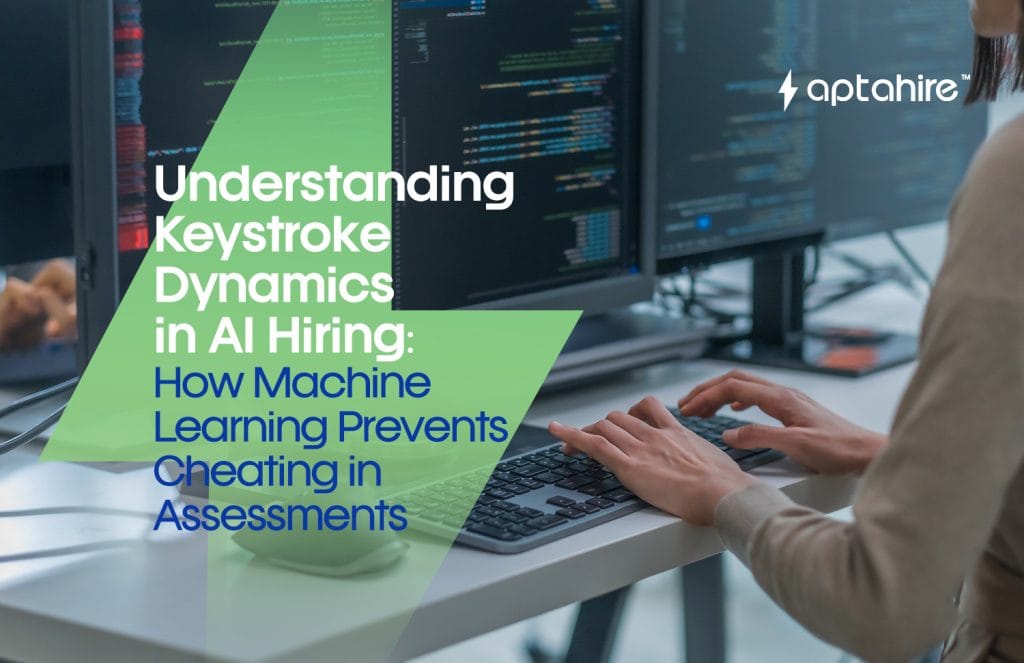Understanding Keystroke Dynamics in AI Hiring: How Machine Learning Prevents Cheating in Assessments

Introduction: The Hidden Language in Your Typing
When you sit for an online test or type out an answer in a virtual interview, you probably think only your words matter. But in the world of AI-powered hiring, how you type is just as important as what you type. This “how”, your unique rhythm, speed, pressure, and pause patterns, is what we call keystroke dynamics.
It’s like a fingerprint, but for your keyboard. Just as no two people have the same walking style or handwriting, no two people type in exactly the same way. And that’s where AI and machine learning step in, turning this subtle, invisible behavior into a powerful anti-cheating tool.
In a hiring landscape where remote interviews and assessments are becoming the norm, ensuring candidate authenticity is critical. Keystroke dynamics isn’t just a tech gimmick; it’s a science-backed, security-focused method that’s quietly revolutionizing virtual hiring.
What is Keystroke Dynamics?
Keystroke dynamics is a form of behavioral biometrics that studies how a person types. It considers factors like:
- Typing Speed – Words per minute, pauses, and bursts of speed.
- Flight Time – The time between releasing one key and pressing the next.
- Dwell Time – How long a key is held down.
- Error Patterns – Frequency and style of backspacing, correcting, or hesitating.
- Rhythmic Signature – The unique cadence of typing.
By analyzing these patterns, AI can detect if the typing suddenly changes, an indicator that someone else might have taken over, or that the candidate is copying and pasting from another source.
How Machine Learning Supercharges Keystroke Dynamics
Machine learning models can be trained on baseline typing data collected from the candidate during initial practice tests or onboarding. Once the model understands the candidate’s unique pattern, it can detect deviations in real-time during the actual assessment.
Here’s what happens under the hood:
- Data Capture – Every key press, pause, and correction is recorded in milliseconds.
- Feature Extraction – The AI transforms these raw inputs into measurable patterns.
- Model Training – ML algorithms (like Random Forests or Neural Networks) learn what “normal” looks like for that individual.
- Anomaly Detection – During the test, any significant deviation (e.g., slower typing, irregular rhythm, unnatural pauses) triggers a review.
- Fraud Flagging – If the deviation suggests impersonation or copy-paste cheating, it’s flagged for the recruiter.
This system doesn’t just detect fraud, it also works silently in the background, so genuine candidates can focus on their answers without distraction.
Why It’s a Game-Changer for Virtual Hiring
1. Identity Verification Without the Hassle
Unlike webcams or invasive proctoring tools, keystroke dynamics works quietly in the background, providing seamless authentication without privacy concerns.
2. Real-Time Cheating Detection
If the AI detects suspicious typing patterns mid-assessment, it can alert recruiters instantly, no waiting for post-test reviews.
3. Zero Dependence on External Devices
No need for eye-trackers, audio devices, or complicated software. Keystroke monitoring is built directly into the assessment platform.
4. Bias-Free Security
Typing patterns aren’t influenced by a candidate’s appearance, accent, or environment, ensuring a fairer assessment process.
5. Cost Efficiency
AI-driven keystroke analysis is significantly more affordable than live proctoring, while delivering equally strong security.
Interesting Real-World Applications
- Banking Exams – Large-scale competitive exams in countries like India use keystroke tracking to prevent impersonation fraud.
- Corporate Skills Tests – Fortune 500 companies integrate keystroke monitoring into coding challenges to ensure originality.
- Remote Education – Universities use it to maintain academic integrity during online exams.
In fact, according to a ResearchGate study, keystroke dynamics can achieve over 95% accuracy in user verification when trained with enough baseline data.
Balancing Security and Candidate Comfort
While keystroke analysis is powerful, its implementation must be transparent and ethical. Candidates should know their typing patterns will be monitored, not to intimidate them, but to protect the integrity of the hiring process.
Forward-thinking companies also combine keystroke dynamics with other fraud-prevention measures like plagiarism detection, webcam monitoring, and behavioral AI for a multi-layered security net.
Conclusion: Your Keyboard Never Lies
In virtual hiring, the most telling clues often hide in plain sight, or in this case, in plain keystrokes. AI-powered keystroke dynamics offers a subtle yet highly effective way to ensure that assessments are honest, fair, and free from external interference.
By leveraging machine learning to track typing behavior, organizations can protect test integrity, uphold fairness, and hire with confidence. In a time when remote hiring is becoming the norm, the keyboard might just be your best security guard.
The bottom line?
You can fake a smile on camera, but you can’t fake your typing DNA.
FAQs
1. What is keystroke dynamics in AI hiring?
Keystroke dynamics is the analysis of how a person types; including speed, rhythm, and pressure, to verify their identity and detect unusual behavior during online hiring assessments.
2. How does keystroke dynamics help in preventing cheating?
By monitoring typing patterns, AI can detect if the test is being completed by someone other than the candidate, if copy-pasting is happening, or if responses are being typed unnaturally fast or slow.
3. Is keystroke dynamics only about typing speed?
No. It’s much more detailed. It includes typing rhythm, time gaps between keystrokes, use of backspace, error corrections, and even the overall typing “signature” unique to each person.
4. Can AI really identify if someone else is taking the test?
Yes. Machine learning models create a baseline of the candidate’s typing behavior and compare it to live test data. If the patterns don’t match, it flags potential impersonation.
5. Is keystroke monitoring intrusive or does it capture personal data?
Keystroke dynamics does not record what you type (the actual text). It only tracks how you type, ensuring privacy while maintaining assessment integrity.
6. How accurate is keystroke dynamics in detecting cheating?
Studies show keystroke-based authentication can achieve accuracy rates of 90–97%, depending on the complexity of the model and amount of data collected.
7. Can candidates “fake” a typing pattern to avoid detection?
It’s extremely difficult. Typing rhythm is a subconscious behavior that’s hard to replicate intentionally. Even small deviations can be detected by advanced AI models.
8. Does this technology work across different devices?
Yes, though accuracy can vary slightly between keyboards and devices. AI models often normalize this variation to maintain consistent fraud detection.
9. Is keystroke dynamics used only for hiring tests?
No. It’s also used in cybersecurity, banking authentication, and online exam proctoring, making it a trusted method for identity verification.
10. Will this technology affect genuine candidates?
Not at all. If you’re completing the assessment yourself without any unfair help, your typing pattern will naturally match your baseline, and you’ll pass without issues.



